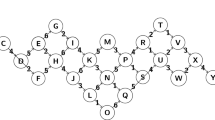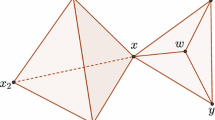Abstract
It has been shown recently that the same multiplicity function appears in direct integral decompositions of both induced and restricted representations on exponential solvable groups — that is, a generalized form of Frobenius Reciprocity is valid. Qualitative results on that multiplicity function in the completely solvable case are proven in this paper — namely, necessary and sufficient conditions for finiteness and boundedness are obtained. The proof uses techniques from ‘pseudo-algebraic geometry’.
Similar content being viewed by others
References
Corwin, L. and Greenleaf, F., ‘Direct integral decompositions and multiplicities for induced representations of nilpotent Lie groups’, Trans. Amer. Math. Soc. 304 (1987), 549–583.
Corwin, L. and Greenleaf, F., ‘Spectrum and multiplicities for restrictions of unitary representations in nilpotent Lie groups’, Pacific J. Math. 135 (1988), 233–267.
Corwin, L. and Greenleaf, F., ‘Complex algebraic geometry and calculations of multiplicities for induced representations of nilpotent Lie groups’, Trans. Amer. Math. Soc. 305 (1988), 601–622.
Fujiwara, H., ‘Représentations monomiales des groups de Lie nilpotents’, Pacific J. Math. 127 (1987), 329–352.
Fujiwara, H., ‘Représentations monomiales des groupes de Lie résolubles exponentiels’, Progress in Math. 82 (1990), 61–84.
Fujiwara, H., ‘Sur les restrictions des représentations unitaires des groups de Lie résolubles exponentiels’ (preprint).
Lipsman, R., ‘Orbital parameters for induced and restricted representations’, Trans. Amer. Math. Soc. 313 (1989), 433–473.
Lipsman, R., ‘Induced representations of completely solvable Lie groups’, Ann. Scuola Norm. Sup. Pisa 17 (1990), 127–164.
Lipsman, R., ‘Restricting representations of completely solvable Lie groups’, Canad. J. Math. 42 (1990), 790–824.
Lipsman, R., ‘The Corwin-Greenleaf parity result fails for completely solvable Lie groups’, Proc. Amer. Math. Soc. 108 (1990), 1131–1132.
Lipsman, R., ‘Orbital decompositions of induced representations for non-simply connected nilpotent Lie groups’, Bull. Austral. Math. Soc. 42 (1990), 293–306.
Milnor, J., ‘On the Betti number of real varieties’, Proc. Amer. Math. Soc. 15 (1964), 275–280.
Risler, J.-J., ‘Some aspects of complexity in real algebraic geometry’, J. Symbolic Comput. 5 (1988), 109–119.
Author information
Authors and Affiliations
Additional information
Research supported by DMS 87-00551A02.
Rights and permissions
About this article
Cite this article
Lipsman, R.L. The multiplicity function on exponential and completely solvable homogeneous spaces. Geom Dedicata 39, 155–161 (1991). https://doi.org/10.1007/BF00182291
Received:
Revised:
Issue Date:
DOI: https://doi.org/10.1007/BF00182291




